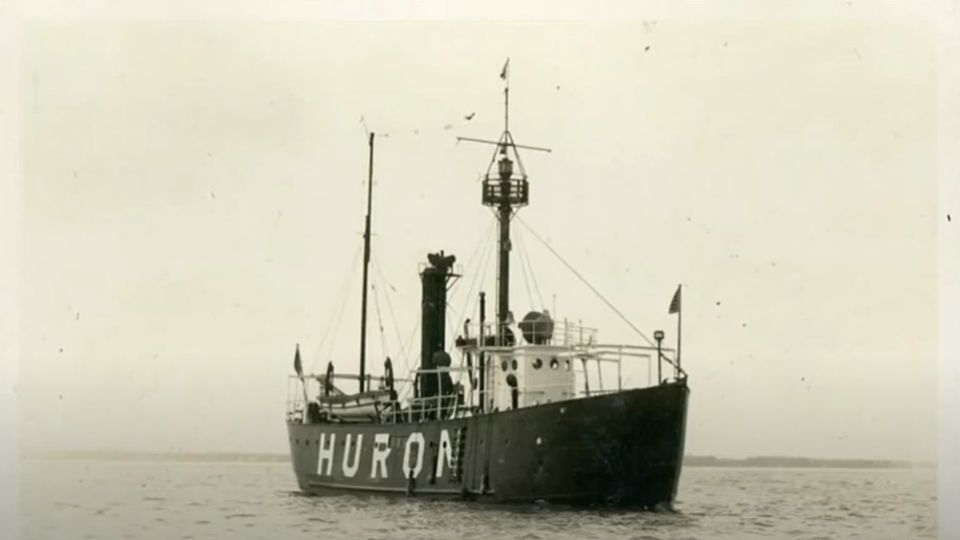Lightships serve as floating lighthouses, usually stationed in locations where building a fixed lighthouse is difficult or not feasible. They have been used to help sailors navigate along the coast of the United States and other countries since the early 19th century. With modern technology, lightships have become outdated, replaced by buoys, satellites, and radar.
The Huron, Lightship No. 103, was among the final lightships still in service on the Great Lakes. Introduced in 1920, this ship was specifically created for use on the Great Lakes and is the only remaining lightship from the 96-foot class. The Huron was decommissioned in 1970 after serving at various stations on Lake Michigan and Lake Huron. It was later moved to the City of Port Huron, where it currently operates as a museum and historical site.
The History of the Huron Lightship
The Huron was built by the Consolidated Shipbuilding Corporation in Morris Heights, New Jersey, at a cost of $147,428. Constructed between 1918 and 1920 as a replacement for the old wooden lightships in the U.S. Lighthouse Service fleet, this vessel was crafted from steel and had dimensions of 96 feet in length, 24 feet in width, and 9 feet in depth. The Huron had a crew of 11 men and was outfitted with a 375-horsepower diesel engine, a 12-inch steam whistle, a 1,000-watt electric lamp, and a fog horn.
- IRS Grants Extra Time for 2024 Taxes to Kentucky’s April Storm Survivors
- Fed’s June Meeting: Rate Cuts Not in the Cards: What’s Next?
- Deadline Alert: Michigan Schools Must Act Fast with Federal Stimulus Funds
- How to Access VA Dependent Education Benefits with a 100% Disability Rating
- Big News for SSDI: Social Security Might Add $600 to Payments
The Huron was launched on May 1, 1920, and went through trials before being accepted by the U.S. Lighthouse Service on December 4, 1920. It was assigned to different stations on the upper Great Lakes to indicate hazardous shoals and reefs. The Huron’s initial station was at North Manitou Shoal in Lake Michigan from 1921 to 1934, and then moved to Grays Reef in Lake Michigan from 1934 to 1935. Its last and most extended stop was Corsica Shoal in Lake Huron, where it operated from 1935 to 1970.
The Huron ship stopped close to the shallow area, using light and sound signals to alert other boats. It shared information with other ships using radio and semaphore, providing updates on weather and ice conditions to the Coast Guard. The crew faced challenging weather conditions, isolation, and monotony, receiving supplies and support every two weeks from a tender and undergoing yearly maintenance at a nearby port.
Also Read: South Texas City Gaining Fame for Its Irrigation-pipe Art Murals
The Huron’s service ended on August 20, 1970 and was replaced by a lighted buoy. This was the final lightship to function on the Great Lakes and the second-to-last in the United States. It was decommissioned in Detroit on August 25, 1970, and then transferred to the City of Port Huron on June 5, 1971. Established at Pine Grove Park on August 29, 1972, it was officially dedicated as a historical monument and exhibit on October 4, 1974.
Visit the Huron Lightship Museum
The Huron Lightship Museum, managed by the Port Huron Museum, welcomes visitors from April to December. Visitors have the opportunity to discover the ship, understand its history, equipment, and daily life on board. The museum showcases displays, items, and souvenirs connected to the Huron and other lightships. This location has been acknowledged as a state and national historic site and was granted National Historic Landmark status in 1989.
The Huron Lightship Museum is a special and important attraction that helps preserve maritime history, which is sometimes not given enough attention. The Huron is the only lightship left in Michigan from its era, symbolizing the important function lightships served in safeguarding the Great Lakes’ navigation and trade. It serves as a tribute to the bravery and commitment of the men who served on these ships. If you have a fascination with lighthouses, ships, or history, you should definitely check out the Huron Lightship Museum.



Leave a Reply